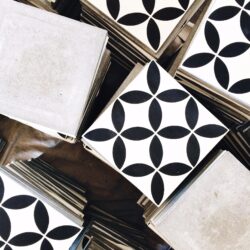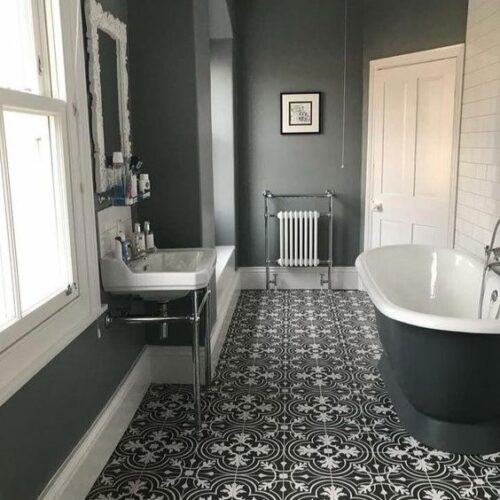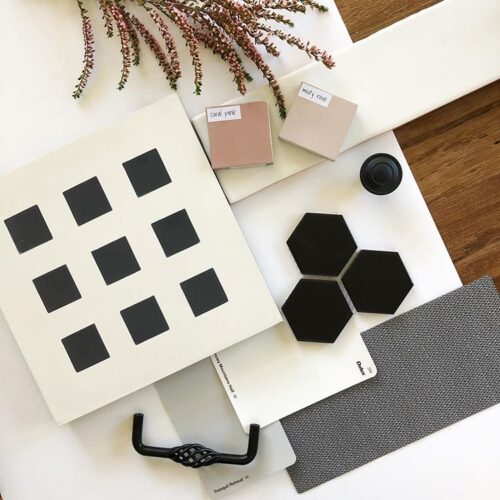Encaustic Cement Tile Guides for Installation and Care
- As each tile is individually handmade, you can expect slight variations in thickness (+/- 1mm), shade and pattern, some irregularity along edges, minor chipping, and on rare occasions crazing. These are inherent to this product and add to the tiles natural appeal, they do not compromise the performance of the tile. White powdery residue may also be present on the surface of the tiles, this is just a result of the curing process. It is easily wiped off with a wet cloth and once the tiles have been sealed it will disappear.
Essential Insights
- Do not leave them outside – keep them in a safe place indoors until ready for installation.
- Variation is to be expected – lighter, darker, less, or more intensely hued, each tile will be different.
- Mix the tiles to avoid clusters of shade variation – select pieces from different boxes. To achieve the desired outcome, it is recommended to undertake a dry lay before proceeding with the installation.
- Clean the tiles during installation – remove surface residue during installation, thoroughly clean and ensure they are dry before sealing.
- Seal the tiles with a solvent-based sealer – to seal the tiles a high-quality solvent-based sealer is needed. It is essential to apply a minimum of two coats and strictly adhere to the instructions provided on the label. For wet areas and external settings, consider applying additional coats as needed.
- Apply first application of sealer before grouting – second and later applications to be applied after grouting. For vertical surfaces, seal the tiles prior to installation.
- Do NOT use dark coloured grout – a cement grout in light/medium grey is recommended.
- Do NOT use acid-based cleaning products – vinegar, ammonia and bleach detergents are not suitable. Use a pH neutral cleaner and warm water (Earth washup detergent, KOH or similar).
Pre-Installation
- Our tiles are pre-sealed in order to better protect them on their journey to your door. Although they are pre-sealed, please do not leave them outside to face the elements. They should be kept in a dry area, until ready to install.
- Even when the same colour mix is used, each tile will dry slightly different making every tile unique with its own variation in shade. It is the natural properties of the cement and marble powder, combined with the earthen nuances of the mineral-based pigments that creates this unique finish. Variation is to be expected – lighter, darker, less, or more intensely hued, each tile will be different. This variation is not a fault, it is part of the charm and is one of the most appreciated characteristics of Cement Tiles. Mixing of your tiles to avoid clusters of shade variation is recommended, pieces should be selected at random from different boxes.
- The following are suggested guidelines for installers. Each job will be different, and the installer is ultimately responsible for ensuring correct installation, grouting, and sealing of the tiles.
Installation
- Tiles need to be installed on a level, clean, dry surface. If the tiles are to be installed on a concrete slab, ensure the slab is completely cured to prevent white efflorescence spots from appearing on the surface of the tiles. The spots are a result of water evaporating through the tile and reacting with the cement. The powdery residue that remains is easily removed; with routine cleaning of the tiles, it will gradually disappear.
- When installing in wet areas, waterproofing of your substrate is necessary as is the case for all types of tiles.
- Adhesive should be applied evenly on the floor or wall surface, and to the back of each tile using not less than an 8mm notched trowel. A flexible adhesive that is suitable for use with moisture sensitive tiles is recommended. Any residue left on the surface of the tile needs to be cleaned off. Depending on the type of adhesive used, dampening the back of the tile first may be required.
- Lay the tiles using hand pressure only using a forward and back motion to enable good contact with the adhesive; by no means should a tool be used, including a rubber mallet, as this has the potential to damage the tile. As the tiles can vary slightly in thickness (+/- 1mm) using your hands to level will ensure a flat surface.
- Do check your pattern layout regularly to ensure tiles are laid in the correct orientation. Use a thin grout line when installing cement tiles; 1-1.5mm is suggested. Minimizing the grout line will make the design look seamless and your space look larger.
- Tiles should only be cut using a wet saw with a diamond blade.
- Following installation, tiles should be left to dry completely before sealing. Do not allow contaminants, including water, to pond on the tiles.
- Please note cement tiles are not frost proof and should not be installed outdoors where exposed to extreme frost conditions.
- Rever Tiles does not accept responsibility or liability for tiles once cut or installed.
Sealing
- Like natural stone, cement tiles are porous and therefore need to be sealed, using a solvent based penetrating sealer. Unlike topical sealers which create a barrier on the surface of the tile blocking the pores of the concrete, penetrating sealers work by repelling liquids, allowing air to still move through the pores and let the material breathe naturally. This provides lasting protection for the tile while preserving the look and natural integrity of the surface.
- As our tiles are pre-sealed some penetrating sealers are not compatible. We recommend using STAIN-PROOF Premium Impregnating Sealer (formerly STAIN-PROOF Original) or for splashbacks exposed to cooking oil splatter STAIN-PROOF Dense Stone Impregnating Sealer (formerly STAIN-PROOF Plus) both products by DRYTREAT. Be sure to follow the instructions as supplied. The tiles need to be completely free of contaminants and completely dry before sealing. A first coat should be applied prior to grouting; the sealer then reapplied after grouting. We have found that using a white cloth or lamb wool applicator to apply the sealer is the easiest application method.
- For vertical installations, such as splashbacks and feature walls, applying the sealer prior to installation of the tiles is generally a better option as you don’t get runoff and the sealer has time to penetrate into the tile. A coat of the sealer will also need to be applied after they have been installed and grouted.
- For bathroom installations where tiles are installed in the shower and for splashbacks where they are exposed to cooking splatter, we recommend applying a further 1-2 coats to ensure the tiles are well sealed. For external installations we also recommend a third coat be applied.
- One of the attributes of cement tiles is that they improve with age and wear, developing an appealing patina with time. In heavy traffic areas or those subject to greater wear re-sealing the surface may be required every 2-3 years, they just need a good clean before you re-seal. For other areas, it is unlikely that you will need to re-seal under 10 years.
- For external installations where there is full and continuous sun exposure, your tiles should first be sealed with STAIN-PROOF Premium Impregnating Sealer (formerly STAIN-PROOF Original). We then recommend applying STAIN-PROOF Colour Enhancing Sealer (formerly STAIN-PROOF Intensifia) to provide longer lasting protection from harsh UV light and for superior stain protection. Allow minimum 4 weeks for the STAIN-PROOF Premium Impregnating Sealer to cure before applying the STAIN-PROOF Colour Enhancing Sealer. Be sure to follow the instructions as supplied and always test product on a small inconspicuous area first and allow a 24-hour cure time to check results. Please note that the colours within the tile will be enhanced with the use of this product. As this product is quite viscous to buff off the residue will take time, it is however necessary to do so. The surface will feel slightly tacky to the touch for a few days. Full cure takes 3-4 weeks. Additional coats can be applied at any time in the future to a cleaned surface. As each area of installation differs the requirement to reseal varies significantly.
- Do not apply the Colour Enhancing Sealer directly to the tiles without first using the Premium Impregnating Sealer as the result can be patchy and uneven.
Grouting
- Due to the porosity of encaustic cement tiles a non-pigmented, cement grout (made from a cementitious powder mix) is recommended in a neutral grey, the traditional shade for these historic tiles. DO NOT use dark coloured grouts as they contain fine carbon pigment, which is very invasive and can cause staining. A popular choice which works well with many of our tiles is Davco Sanitized Colourgrout in a shade called Cashmere. Test your grout selection first on remnant or excess tiles, or a small area of the surface to ensure you are satisfied with the results.
- The surface of the tile should be continually cleaned during the grouting process to prevent the grout from setting on the surface of the tiles.
- Remember that you need to reapply the sealer after grouting. Make sure the tiles are clean, free of contaminants and fully dry before applying this second coat.
- Whilst further works are being carried out, take care to protect your tiles by covering with plain cardboard or a heavy drop sheet. Do not affix duct tape, gaffer tape or similar directly onto the surface of the tile as it may discolour or stain your tiles.
Cleaning
- After installation, cement tiles require little maintenance. Light cleaning should be performed routinely with a pH neutral cleaner and warm water.
- For a more thorough clean we recommend STAIN-PROOF Daily Floor Cleaner (formerly known as Rejuvenata Active), an environmentally responsible, natural enzyme cleaner suitable for natural stones, tiles, grout and other hard surfaces. For a deep clean or for major stains then we recommend STAIN-PROOF Alkaline Cleaner, (formerly known as Oxy-Klenza) a powerful triple action heavy duty cleaner.
- Do not use acid-based cleaning products such as vinegar or ammonia or any type of bleach detergent, as they tend to start breaking down the sealer and may ultimately damage the surface of the tiles. Abrasive cleaning cloths such as scouring pads or scrubbers should be avoided.
- Since the pores of the tile remain open, the surface is not entirely immune to staining, therefore harsh spills (i.e. red wine, oil) and acidic spills (i.e. lemon juice) should be wiped up as soon as possible. The penetrating sealer will slow the absorption of the spill, so don’t worry, you have time to clean it up without the worry of staining, but just don’t leave it. Water spotting will be eliminated through an ongoing cleaning routine.
- If the surface of the tile gets scratched, super-fine grit sandpaper can be used to buff out the scratches, which will then need to be re-sealed. The use of walk-off mats at entrances and sweeping of the tiles is important to remove abrasive grit that may cause scratches.
- After a lifetime of wear, you may wish to rejuvenate the surface of your beautiful tiles. If this is the case, then a single disc floor polishing machine with white (light duty) pad may be used.



